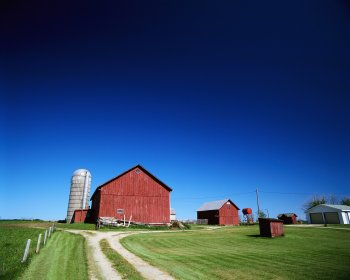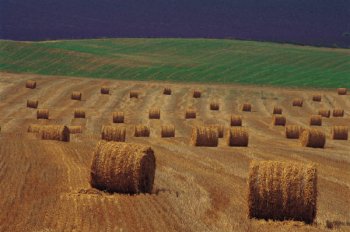

To send a message to an author, click on the author's name at the end of the article.
This Month in Ag Connection | Ag Connection - Other Issues Online
During the last week of April, beef producers had the opportunity to tour two Kansas feedlots. Missouri Beef Council, producers, regional livestock specialists, state specialists, several AI companies and others were all involved with making the trip a success. These tours are a great way for producers to see what happens to their calves after they are sold either through a sale barn or video auction (or another way). Participants also had the opportunity to visit a Tyson beef processing plant. For producers who have never been in a large scale slaughter plant, it is truly amazing to watch the efficiency of an entire carcass broken down for consumer markets. It is also true that processing plants use everything but the "moo" with the exception of spinal and brain material, that now goes to the land fill due to the 2003 BSE event.

Participants were challenged to "think differently" by several industry experts. Bill Haw, the CEO of National Farms, one of the largest cattle outfits in the country stated "If producers want to stay in the cattle business, the same things that used to work in the past will no longer work for today's market." This comment was based on the fact that cow-calf numbers are lower now than they have been since the 1950's and beef demand has been declining for years. Mr. Haws' comments were a bit harsh, but might be a reality check for those in the cattle industry. Getting carcass data back on calves is important on figuring out what is and isn't working. The one thing continually conveyed was the need for improved quality and consistency of the meat supply. It has improved over the years, but there is still a lot of room for improvement. If American producers want to stay competitive in our global economy, smaller operations pooling their resources together might be one way of "getting it done".
Smaller operations should consider pooling resources to achieve better genetics and lower prices on inputs. Comingling cattle attracts interest from buyers and feedlots. The MU Extension Premier Beef Program helps producers take advantage of these strategies. If Central Missouri producers are interested in the program contact your local livestock specialist.
Source: Wendy Rapp, MU Extension Livestock Specialist
This Month in Ag Connection | Ag Connection - Other Issues Online

In case you have been preoccupied with actual farming, here's a catch-up of congressional action to develop a new farm bill. The proposal being debated at the time of this writing was passed in late April by the Senate committee responsible for agriculture. On June 5th the full Senate voted overwhelmingly to open debate on the proposal—read that as open for amendments and negotiations. The House agricultural committee has been active, but has not yet released a document for review or analysis.
This is a five-year farm bill for the fiscal years 2013-2017 which begins Oct 1 of this year. See a summary of the entire bill herehttp://www.ag.senate.gov/issues/farm-bill
Two of the most discussed changes in the commodity title are the elimination of the direct and counter-cyclical payment program (DCP) and the creation of a new crop revenue insurance program currently labeled agriculture risk coverage or ARC. This is a clear shift in policy direction from government support based on history to support via risk management of current production. It seems prudent to begin assessing how these changes might impact your farm business. A good place to start is to review how your program base aligns with your current planted acres and crop rotations.
Recall that the direct payment is a fixed, annual amount. For practical purposes, the amount received today is the same as when the program began ten years ago. If you are a central Missouri crop farmer, chances are very high this is the only payment you have received for several years. This October would be the last direct payment under the proposal.
The key point is that direct payments are calculated from historical program base acres and base yield, last updated under the 2002 farm bill. This means the direct payment received may, or may not, match current production. Some direct payments go to landowners without any production. With the new ARC program (coupled with traditional crop insurance), support will be calculated based on your planted acres.
How you view the proposal will, in part, be determined by how current production matches your base. If your planted acreage exceeds your base, you are more likely to look favorably at this policy shift. If your base acres are high relative to your planted acres, and/or your direct payments are very valuable, you might not like this proposal.
Nationally, direct payments per base acre are about $23.40 for corn, $11.10 for soybeans, and $14.84 for wheat. Direct payments per base acre are substantially higher for cotton, rice, and peanuts.
Farm bills are notorious for regional politicking and this bill is no different. Many possible outcomes are still in play so stay tuned.
Source: Brent Carpenter, MU Extension Ag Business Specialist
This Month in Ag Connection | Ag Connection - Other Issues Online
When baling and handling large round bales, one must recognize and understand potential hazards and follow the manufacturer's operating recommendations for each piece of equipment. The round baler is a complex machine with multiple moving parts, and an entanglement incident normally leads to costly repair bills, injury, or death.

Prior to using the baler each season, one should:
- thoroughly inspect it
- make any needed repairs
- review all of the safety precautions in the owner's manual.
The size and rated horsepower of the tractor used with your baler must meet the manufacturer's requirements for towing and powering the baler.
Safety Recommendations
Material summarized from Safety Recommendations When Baling and Handling Round Bales. (2012) Farm and Ranch eXtension in Safety and Health (FReSH) Community of Practice. Retrieved from http://www.extension.org/pages/64301/safety-recommendations-when-baling-and-handling-round-bales
Submitted: Kent Shannon, MU Extension Natural Resource Engineer Specialist
This Month in Ag Connection | Ag Connection - Other Issues Online
While the early green-up of pastures and hay fields followed by extended periods of dry weather were a perfect recipe for harvesting cool-season forages for hay, the growing season of 2012 continues to throw curve balls at producers throughout Missouri. The problem is that the month of May, normally one of our wetter months in the year, has turned out to be abnormally dry. Some areas are experiencing slow pasture and hay field growth due to dry conditions. Dr. Justin Sexten, MU Extension Beef Nutrition Specialist, highlights two nutrient demand reduction strategies in response to drought.

The first option is early weaning calves. Young cows and first calf heifers should be the first candidates for early weaning, followed by thin cows, early calving cows, and finally late calving cows. Be thinking how to accomplish this task if necessary and decide what you are going to do with the calves after you wean them: evaluate facilities, feeding programs tailored for young calves, and marketing alternatives.
Forage resources should be inventoried and monitored. Set minimum cover thresholds and remove cattle from pastures reaching that level. Identify a sacrifice pasture or area to abuse. Thin or weedy pastures in need of renovation are good candidates. This area can be used to feed hay, if necessary, and then plan on renovating when moisture conditions improve. Possibilities for filling unmet forage needs include: renting additional pasture, harvest accumulated forages, harvesting emergency hay crops such as warm-season annuals, or purchasing hay.
Strategic culling is a second option. The recommended order of culling: open cows, old cows, late bred young cows, late bred older cows and low production cows. Prioritize forage needs based on stage of production, with late gestation cows in need of additional condition having the highest priority and dry cows having the least priority.
Developing a plan before a crisis occurs may avoid expensive mistakes based on spur of the moment decisions and provide time to prepare livestock and facilities in case drastic actions are warranted later in the summer.
Source: Gene Schmitz, MU Extension Livestock Specialist
This Month in Ag Connection | Ag Connection - Other Issues Online
Some portions of the Internal Revenue Code are crystal clear and leave little room for different interpretations; other portions of the Code are far less clear and definitive. The Code and Regulations regarding deductibility for the cost of removing brush, trees, and hedge rows fall into the latter category. The expenditure for removing brush and trees or a hedge row on a farm may:

An expenditure is deductible as an ordinary business expense if it maintains the productive capacity of the property, rather than extending its productive life or preparing the property for a new productive use. The Code requires if the cost of removing brush and trees is not an ordinary expense, then it must be capitalized into the related improvement or basis of the land, unless it qualifies as a deductible soil and water conservation expense. Soil and water conservation expenditures are amounts spent to conserve soil and water, or to prevent erosion and are treatments consistent with a conservation plan approved by the Natural Resource Conservation Service or a comparable state agency.
Trimming trees along the border of a field so farm equipment can pass under trees without damaging equipment is an expenditure considered an ordinary and necessary business expense, thus deductible.
Now, for a case a little more controversial. Farmer "A" purchased a farm that had been neglected for several years. Farmer "A" spent $2,300 removing trees that had grown up in the pastures. Can Farmer "A" claim this expenditure as an ordinary and deductible business expense? The answer is not definitive! At least one court case held the cost of restoring the land to its original use is a capital expenditure. However, many tax professionals believe it is permitted and proper to deduct the expense associated with routine brush clearing as maintenance of pastures. The issue is, was the removal of the trees routine brush clearing and maintenance?
The removal of a hedgerow to facilitate the use of larger equipment is less controversial. This expenditure is not currently deductible, nor depreciable - the cost is added to the cost basis of the land.
However, if the hedgerow is removed to facilitate the building or rebuilding a fence, the expenditure is considered a cost of installing the fence and can be recovered via depreciation of the fence.
Careful analysis of your unique circumstances will determine the proper tax treatment of your expenditures involving removal of brush, trees, and hedgerows. If your tax return happens to be audited, your description of the reason for the expenditure and land usage before and after the brush and tree removal will be critical to how the IRS views the deductibility of this expenditure.
Source: Parman R. Green, MU Extension Ag Business Mgmt. Specialist
This Month in Ag Connection | Ag Connection - Other Issues Online
Publishing Information
Ag Connection is published monthly for Northeast and Central areas of Missouri producers and is supported by the University of Missouri Extension, the Missouri Agricultural Experiment Station, and the MU College of Agriculture, Food and Natural Resources. Managing Editor: Mary Sobba.